Is your business ready for the big one billion?
Digital commerce is undoubtedly the headline topic of the retail industry today. The sector has quadrupled growth since 2017 to reach a revenue figure of US$ 211 billion in 2022 in eight high growth markets, including India.
Given the pace with which e-commerce is growing, it can open unprecedented pathways to growth for companies that deliver relevant and engaging digital experiences. But are companies ready?

Image Source: Shutterstock
Digital commerce, also known as e-commerce, has been experiencing rapid growth in recent years. With the increasing proliferation of smartphones, internet connectivity, and digital payment systems, more and more consumers are choosing to shop online. This trend has been further accelerated by the COVID-19 pandemic, as lockdowns and social distancing measures have led to a surge in online shopping.
As a result, e-commerce has become an increasingly important component of the global economy, offering businesses new opportunities to reach customers’ and ensuring far higher customer convenience. And ultimately, it is enabling access to a far broader range of products and services. With this, the world is seeing a gigantic surge in the number of digital consumers, and another large number is expected to knock on the digital door as we move further in time.
A Billion More Consumers
According to a recent global commerce study, eight of the fastest-growing countries are expected to produce over one billion digital native consumers within the next decade. The list of countries includes India, Bangladesh, Egypt, Ethiopia, Indonesia, Kenya, Nigeria and the Philippines.
The study by Accenture highlights that these e-consumers are predominantly aged between 6 and 26 and represent 36% of their respective populations. Additionally, the research found that digital commerce revenues have quadrupled in these markets since 2017 — equating to US$ 211 billion in 2022. This presents a significant opportunity for companies looking to tap into the next wave of commerce-driven growth.
However, the report also warns that most multinational companies may not be prepared to attract this demographic from these eight emerging markets. Therefore, they will need to adjust their strategies and tailor their offerings to appeal to this particular consumer base.
New Challenges to Hop In
These emerging markets will create challenges for multinationals. It will be a whole new world with a different set of demographics, and thus challenging for multinationals to attract and capture the growing number of digitally native consumers.
These markets have unique characteristics that require digital and fully harmonized cross-channel ecosystems, which the multinationals may not be prepared to provide. To capture these markets, companies need to have the ability to apply insights in real-time from rich data analytics and influence their partners in the ecosystem to do the same.
In other words, companies need to have a comprehensive strategy in place that takes into account the unique challenges and opportunities presented by these emerging markets.
In a statement, Vineet R Ahuja, Managing Director and Accenture Song Lead in India said, “To win consumers’ hearts, minds and wallets, companies need to develop deeply digital, fully harmonized cross-channel ecosystems for their brands. This will require data insights, technology and partnerships to power agile business models and commerce operations to remain relevant and resonant to the changing needs and aspirations of consumers.”
Overview of the Indian Market
According to the report, the Indian consumer market is characterized by using digital channels, such as search engines, social networks, and videos, to research products or services before making purchases.
A majority of 79% of the respondents surveyed confirmed this trend. Additionally, the report revealed that social media “Likes” and positive comments have a significant impact on the online purchasing decisions of 81% of Indian consumers.
The report also suggests that over half of the emerging consumers in India prefer social media apps over other platforms for shopping. What this mean is that consumers today are supporting the trend of social commerce. With regard to payments, about 65% of Indian consumers prefer online payment methods. The study found that convenient delivery options, such as “click and collect” (80%) and free delivery (83%), are also significant drivers of online purchases in India.
Other than this, the Indian government is actively introducing schemes to boost the e-commerce sector. On 31st March, 2023, the Indian Government unveiled the new Foreign Trade Policy. The policy introduced measures for ease of doing business like e-certificate of origin, online approvals, paperless filing, and facilitating exports through e-commerce.
In addition to this, initiatives like ONDC (Open Network for Digital Commerce) have opened new routes allowing more players to enter the e-commerce infrastructure. This has motivated small or micro exporters to reach international customers without investing in a physical set-up. And to get these budding players ready, a wide range of outreach and training activities will be taken up to enhance their capacity. The major focus here is to encourage artisans, weavers, garment manufacturers, gems, and jewellery designers to be on e-commerce platforms.
A Widened Business Opportunity
India has increased its digital investments in these markets by 15%, since 2016. The country is backing itself up to face the upcoming challenges of the digital era. And, understanding the behaviour and preferences of Indian consumers can help businesses tailor their products and services to meet the needs of their target audience better. For example, knowing that Indian consumers heavily rely on online channels for researching products before making a purchase, businesses can focus on building a strong online presence. This can be done by providing detailed product information on their websites and social media platforms.
Additionally, understanding that social media plays a significant role in influencing buying decisions can help businesses develop effective social media marketing strategies to engage with potential customers.
Brands now have the opportunity to make their platforms more user-friendly for the upcoming 1 billion e-consumers. Companies that act first can gain an advantage by acknowledging the need to be digitally advanced both internally and externally. They can reinvent their commerce model to cater to future consumers’ requirements to generate better revenues in the near future.
Final Word
In sectors where mobile apps serve as the primary means of interaction, there is generally a higher proportion of digital adopters. This “mobile premium” is particularly evident in sectors like edtech, healthcare, fintech, etc., where mobile phone penetration, including smartphones, is high and serves as the most prevalent channel for engaging with businesses.
This presents an opportunity for businesses to reach and engage with this demographic by creating mobile-friendly platforms and online-based business models. By doing so, businesses can improve their accessibility, convenience, and user experience for these consumers. This will ultimately lead to increased customer engagement, loyalty, and revenue generation for the businesses.













Leave a comment